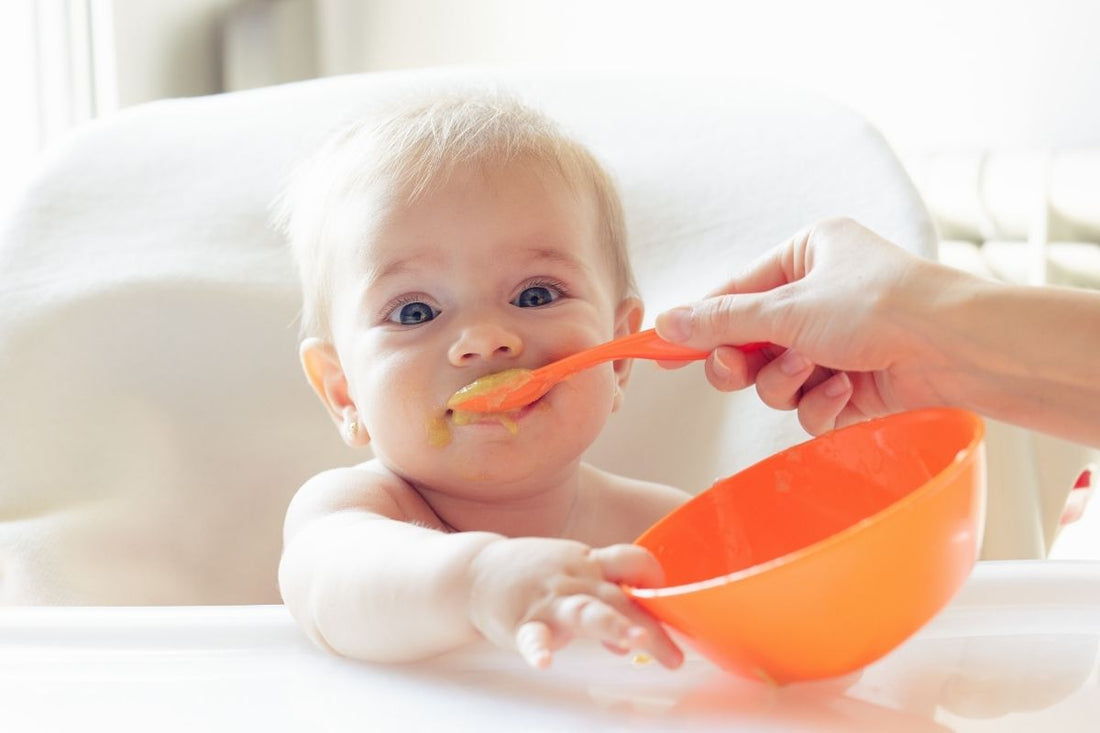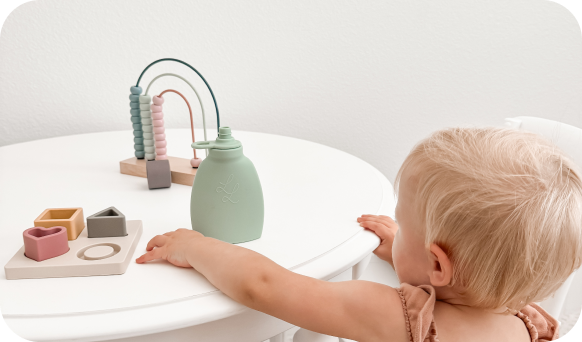The Importance of Texture In Your Baby’s Eating Journey

Hello, I’m Anna and our kids are Theo, 2.5 years old and Julia, 7 months old. Texture is a key thing I’ve realized when it comes to feeding babies. Theo’s first experiences with solids seemed to me more about his meals than anything else. But I quickly realized how he ate it made a huge difference. That’s when I started researching baby food textures and believe me, everything changed for me.
This article is aimed at mothers who are switching their babies from smooth foods to chunkier ones. I’ll show you why texture matters, how to introduce it safely and how using it can improve your child’s chewing and reduce fussiness when eating. Read on to learn more.
Why Texture Is More Than Just a Mouthfeel
You might be wondering, “Isn’t texture just a preference?” Not at this age. Introducing food textures is a key part of babies' sensory and physical development. It teaches them how to:
Chew and move food around their mouths.
- Strengthen their jaw and facial muscles.
- Handle different tastes and consistencies.
- Use their tongue and lips to manage bites.
All of this supports oral motor development. The skills babies need are not just for eating but also for talking! Curious about how to align food textures with your baby's developmental milestones? Check out this guide on Understanding Baby Food Stages: A Guide for New Parents.
When to Start Texture Progression
So, when should you move beyond purées? Most babies are ready between 4 to 7 months. Julia started showing signs around 6-7 months, like:
Sitting up well on her own
- Showing interest in our food
- Moving purée around her mouth easily
- Starting to chew even without teeth
- Picking up soft foods and trying to self-feed
Keep in mind: every baby is different. Follow your child’s cues and take it slow.
A Simple Texture Timeline
Wondering when and how to shift from smooth purées to more complex textures? Don’t worry, I’ve been there too. Here’s a rough outline of how we introduced textures with Theo and now with little Julia as she follows in her big brother’s messy, smiley footsteps. This isn’t a rulebook, just a gentle guide based on what worked in our home.

1. Smooth Purées (6–7 months)
At this early stage, babies are just learning how to move food from the front to the back of their mouths. Smooth purées are easy to swallow and less likely to cause gagging.
Examples:
Mashed banana
- Plain applesauce
- Blended sweet potatoes
- Thin pear puree
Tools we used:
Soft baby spoons
- The Palmetto Pouch for smoother options on the go (lifesaver in the car!)
This stage is all about comfort and calm. Keep portions small and offer one food at a time to help baby learn new flavors and avoid overwhelm.

2. Thicker Blends (7–8 months)
Once your baby gets the hang of swallowing, you can move up to a slightly thicker consistency; think less smoothie, more applesauce with texture.
Examples:
Oatmeal mixed with mashed fruit
- Chunky veggie blends (like carrots + lentils)
- Thicker yogurt with mashed berries
These blends are still smooth enough to go into the Palmetto Pouch but thick enough to challenge your baby’s chewing skills. This is where you’ll notice more tongue and lip movement—great signs of oral motor development.
Keep textures soft, but don’t be afraid to add gentle lumps or grit. It helps the baby learn how to manage different consistencies safely.
3. Soft Mashed Foods and Textured Blends (8–9 months)
This stage is all about building independence. Babies at this age start to grab and scoop and love to smoosh food with their hands. Let them explore!
Examples:
Fork-mashed avocado or steamed sweet potato
- Soft-cooked lentils or quinoa
- Scrambled eggs cut into tiny pieces
- Cottage cheese
Give your baby bits of food and allow them to practice feeding themselves. Being able to touch, smell and taste all in one experience helps children develop sensory feeding. Of course, things get muddled, but that’s a great chance to learn.
Don’t worry if your baby doesn’t “finish” the food. Right now, they’re building skills, not just eating for calories.
4. Soft Finger Foods (9–10 months and up)
At this point, your baby may be ready for more solid textures they can hold and chew. Teeth or not, babies use their gums very effectively!
Examples:
Strips of whole wheat toast or pancakes
- Steamed zucchini sticks or broccoli florets
- Ripe melon or pear slices (peeled)
- Small chunks of soft cheese
Now’s the time to fully embrace introducing food textures and let your baby take the lead. Encourage safe exploration, and always supervise closely. Serving a variety of these foods prevents picky eating for babies by trying different textures early in life. Looking to combine texture exploration with gut health benefits? Discover these 5 Baby Puree Ingredients That Support Gut Development From the Start.
Tip: Offer a single new food or type of food to your child every day during the week. Familiarity builds comfort and comfort builds confidence.
How Texture Supports Sensory Feeding
Have you ever noticed your baby squishing food in their hand before putting it in their mouth? That’s sensory feeding in action. It’s how they explore new foods and feel more in control.
By introducing texture early on, you’re helping them:
Get used to different sensations
- Build trust with food
- Reduce food-related anxiety later
Theo used to gently poke at steamed carrots before tasting them. Julia? She smears avocado across the tray like finger paint but then gives it a go. That’s progress!

Preventing Picky Eating Starts with Texture
Want to know a secret weapon in the battle against picky eating? Texture variety. Studies show that babies who are exposed to multiple textures early are more likely to accept a wider range of foods later. The more they feel, chew, and experience now, the less likely they are to reject foods down the road.
Here’s what worked for us:
Rotate textures weekly (puree Monday, mashed Tuesday, finger foods by Thursday)
- Mix familiar and new, add mashed banana into a new veggie blend
- Use fun names: Theo loved “cloud eggs” (scrambled eggs) and “squish beans” (soft lentils)
Our Palmetto Pouch Texture Trick
One of my favorite tools for this whole journey? The Palmetto Pouch. It’s been a total lifesaver. We started using it for smoothies and soft blends, but now it’s our go-to for thicker meals too. Here’s how it supports introducing food textures:
Lets babies control the pace of feeding
- The spout is very similar to a nipple so the transition is seamless
- Handles both smooth and chunky purées
- Encourages jaw and lip movement, perfect for oral motor development
- Less mess (and less stress for mom!)
Julia especially loves her warm pear oatmeal in the Palmetto Pouch and Theo still uses it for thick yogurt blends.
Safe Texture Progression Tips
Worried about choking? That’s totally normal. Here’s how we made texture introduction safe:
Always supervise meals
- Start with soft foods that mash easily
- Avoid round, hard foods like grapes or raw carrots
- Keep portions small and slow
- Let the baby explore with their hands, yes, even if it’s messy!
Bonus: Learning how to chew and manage textured food can actually reduce choking risk over time.
Texture Win Moments from Our Kitchen
Curious how all this texture talk plays out in real life? Here are a few fun (and messy!) wins from our own kitchen adventures.
Theo’s First Crunch:
We introduced lightly toasted bread fingers around 9 months. He chewed thoughtfully, like a little old man, then clapped for himself. I almost cried.
Julia’s Mash Masterpiece:
Last week, Julia mashed her lentils with banana by hand before squeezing them into her mouth from the Palmetto Pouch. It was a sensory masterpiece and she loved every bite.
Final Thoughts:
Trust me, feeding your baby helps them experience, understand and grow at the same time. Starting with a range of textures helps children feel happy, improve skills and build healthy eating habits for life. So don’t worry about mess. Lean into it. Watch your baby squish, smear, and smile. It’s all part of the journey. And if you need a tool to make that easier? The Palmetto Pouch has your back every squishy, spoon-free step of the way.
References:
1. Boulanger, A.M. (2018). Introduction of New Food Textures During Complementary Feeding. Retrieved from https://www.sciencedirect.com/science/article/pii/S235234091830111X
2. KidsHealth. (n.d.). Feeding Your 4- to 7-Month-Old & Introducing Solids. Retrieved from https://kidshealth.org/parents
3. Kim, A.R. (2021). Sensory-Based Feeding Intervention for Toddlers With Food Refusal. National Institutes of Health. Retrieved from https://pmc.ncbi.nlm.nih.gov/articles/PMC8572996
